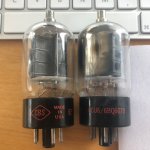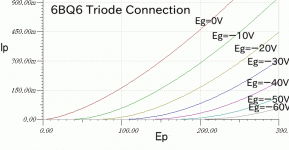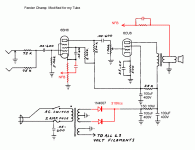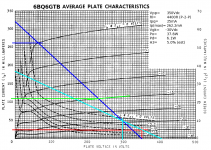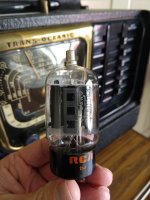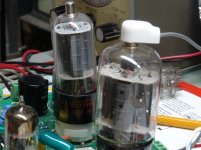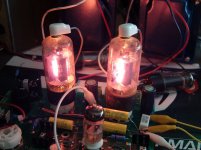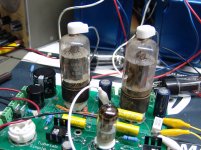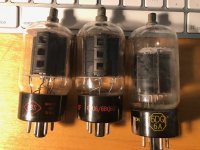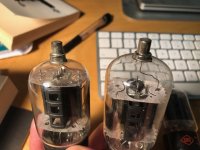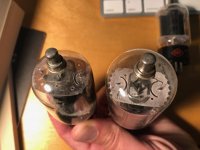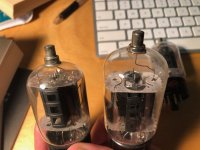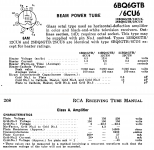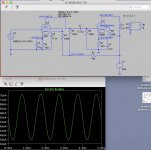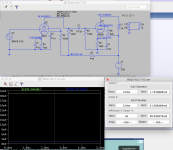I have a pair of 6CU6 / 6BQ6GTB (and also a pair of 12CU6... and 25CU6...) and would like to try designing a single-ended hi-fi amp for them.
There has been some work done with these over the years, primarily in push-pull or for guitar use. My goal is to design a single ended integrated stereo amp, either in triode mode, pentode mode, or switchable between the two.
Here's what I've found so far:
* Ecological Recycling Amplifier -- Ecological recycling amplifier (6CU6)
* Google Groups
* Vacuum Tube User Group
* Using Sweep Tubes for an Amp Build
* 6cu6 12cu6 @ 2a3
* 6CU6 Sweep Tube Monoblock Power Amp Build Log
* Comparing Eight Tubes for Low Power Amplifiers -- http://www.enjoythemusic.com/magazine/manufacture/1108/
Also attached are computer generated load lines for 6BQ6 in triode mode, a schematic of the Renard P-P amp (I believe Miles Prower's circuit), a 6CU6 version of the Fender Champ guitar amp, and the CBS 6CU6 that are in my stash (I've *really* liked all the CBS tubes I've tried so far, especially 6SJ7).
In the datasheets I've not found any common operating conditions for class A1, nor any load line graphs for triode mode, which isn't surprising since these are TV sweep tubes. The Tung-Sol datasheet does give a suggested triode operating condition of:
Eb = Ec2 = 150V and Ec1 = -22.5V
That could be a starting point for triode mode.
I'm trying to figure out what would be a good OPT primary impedance. I've got a pair of 5K:8ohm, 100mA, 15W Electra-Prints. Also a pair of Tektron 3.5K:6ohm & 10ohm, 100mA, 10W. My speakers are 8ohm, so the Tektrons would reflect load impedances of either 2.8K or 4.67K.
The Renard P-P amp uses 4.4K (P-2-P), and the "Eight Tubes" article linked above seems to suggest 2.2K as an OPT primary impedance for SE, which would rhyme with the Renard.
I've also read that that the 11W max dissipation rating can be slightly and safely exceeded for audio use.
So, if anyone has schematics, links, or experiences to share, I'd really appreciate it.
Thanks!
There has been some work done with these over the years, primarily in push-pull or for guitar use. My goal is to design a single ended integrated stereo amp, either in triode mode, pentode mode, or switchable between the two.
Here's what I've found so far:
* Ecological Recycling Amplifier -- Ecological recycling amplifier (6CU6)
* Google Groups
* Vacuum Tube User Group
* Using Sweep Tubes for an Amp Build
* 6cu6 12cu6 @ 2a3
* 6CU6 Sweep Tube Monoblock Power Amp Build Log
* Comparing Eight Tubes for Low Power Amplifiers -- http://www.enjoythemusic.com/magazine/manufacture/1108/
Also attached are computer generated load lines for 6BQ6 in triode mode, a schematic of the Renard P-P amp (I believe Miles Prower's circuit), a 6CU6 version of the Fender Champ guitar amp, and the CBS 6CU6 that are in my stash (I've *really* liked all the CBS tubes I've tried so far, especially 6SJ7).
In the datasheets I've not found any common operating conditions for class A1, nor any load line graphs for triode mode, which isn't surprising since these are TV sweep tubes. The Tung-Sol datasheet does give a suggested triode operating condition of:
Eb = Ec2 = 150V and Ec1 = -22.5V
That could be a starting point for triode mode.
I'm trying to figure out what would be a good OPT primary impedance. I've got a pair of 5K:8ohm, 100mA, 15W Electra-Prints. Also a pair of Tektron 3.5K:6ohm & 10ohm, 100mA, 10W. My speakers are 8ohm, so the Tektrons would reflect load impedances of either 2.8K or 4.67K.
The Renard P-P amp uses 4.4K (P-2-P), and the "Eight Tubes" article linked above seems to suggest 2.2K as an OPT primary impedance for SE, which would rhyme with the Renard.
I've also read that that the 11W max dissipation rating can be slightly and safely exceeded for audio use.
So, if anyone has schematics, links, or experiences to share, I'd really appreciate it.
Thanks!
Attachments
Last edited:
I've used their brother the 6DQ6B in push pull triode. 3K Ra-a, 300V, 60mA. They sound nice and can be run harder than they say.
I've never built an SE amp, but I'd be inclined to try a 1k5 load with 250V and 80-90mA. Since you can't do that by the looks of it, try 300V 60mA into your 2k8 load. Won't have a lot of power, but it'll be very nice. All triode connection.
EDIT: I see now the design was a Fender Champ which implies this is NOT a hifi amp?
I've never built an SE amp, but I'd be inclined to try a 1k5 load with 250V and 80-90mA. Since you can't do that by the looks of it, try 300V 60mA into your 2k8 load. Won't have a lot of power, but it'll be very nice. All triode connection.
EDIT: I see now the design was a Fender Champ which implies this is NOT a hifi amp?
I see now the design was a Fender Champ which implies this is NOT a hifi amp?
This IS a hi-fi amp. I changed the first line in post #1 to reflect that. I posted that guitar schematic as background information for anyone who might want to gain a sense of the field.
Power is not really a concern because this amp will be playing single driver full range speakers in my small home office. I've breadboarded a 7C5 (loctal 6V6GT) amp in triode mode with 6SJ7 as input tube. It puts out about 1.5W and sounds superb. I wanted to try 6CU6 to see if it can be even better (I'm liking the big plates), but it doesn't have as much of a lineage for audio, so I wanted to post a build/advice thread.
Last edited:
Don't put a volume control within a feedback loop.It only changes the open loop gain, not the volume, exept when the loop gain gets too small.
Mona
Mona
Huge 25K screen grid resistor in Fender Champ is there on purpose, for sag on overdrive, when it also decreases voltage for the preamp tube. For hi-fi you need stiff screen grid voltage.
Member
Joined 2009
Paid Member
use proper 3 pronged mains plug, wireearth to chassis and scrap that capacitor from mains live to earth.
Thanks. Yes, proper attention to grounding will always be done. The volume control will be at the input jack.
What I have in mind is something more like the attached screenshot of LTSpice, that I just whipped up quickly using the RCA common input tube resistor chart for 6SJ7 to get the voltage, resistor, and capacitor values for a mu of 55. The 6CU6 triode (shown there as 6BQ6T) is running at 200V across the tube at 45mA. I don't know whether that's a good operating condition for 6CU6 in an audio application. In the "Eight Tubes" article linked above, Damon Coffman suggests running the tube at 75mA. Anyway, the circuit appended here has an input sensitivity of about 0.5V, which is a good number for an amp that would be connected to a ~1V source like a CD Player, DAC, phone, etc.
I love 6SJ7 in a few circuits I've breadboarded, and figured I'd start with that as input tube. I also have on hand 6SC7, 6SQ7, and 6AC7.
What I have in mind is something more like the attached screenshot of LTSpice, that I just whipped up quickly using the RCA common input tube resistor chart for 6SJ7 to get the voltage, resistor, and capacitor values for a mu of 55. The 6CU6 triode (shown there as 6BQ6T) is running at 200V across the tube at 45mA. I don't know whether that's a good operating condition for 6CU6 in an audio application. In the "Eight Tubes" article linked above, Damon Coffman suggests running the tube at 75mA. Anyway, the circuit appended here has an input sensitivity of about 0.5V, which is a good number for an amp that would be connected to a ~1V source like a CD Player, DAC, phone, etc.
I love 6SJ7 in a few circuits I've breadboarded, and figured I'd start with that as input tube. I also have on hand 6SC7, 6SQ7, and 6AC7.
Attachments
Last edited:
6BQ6 / 6CU6 are all over the place in construction. Markings notwithstanding, those tubes in your picture clearly look to be RCA 6GW6/ 6DQ6.
There is actually a fair amount of information on running the 6BQ6, 6DQ6, and other sweeps as triodes and pentodes in the Tubelab sub forum, as this is an easy modification on the SSE. Tubelab has done it; I have done it; probably others.
Running any of these sweep tubes as cathode biased triodes, at any type of reasonable plate voltage, gets you into the realm of really high cathode voltages - you'll probably want 100 volt caps for that position.
They have lower amplification factor than normal audio tubes, so you'll want to keep that in mind.
Pentode with feedback is a better choice, I think, but experiment and see what you like best.
Win W5JAG
There is actually a fair amount of information on running the 6BQ6, 6DQ6, and other sweeps as triodes and pentodes in the Tubelab sub forum, as this is an easy modification on the SSE. Tubelab has done it; I have done it; probably others.
Running any of these sweep tubes as cathode biased triodes, at any type of reasonable plate voltage, gets you into the realm of really high cathode voltages - you'll probably want 100 volt caps for that position.
They have lower amplification factor than normal audio tubes, so you'll want to keep that in mind.
Pentode with feedback is a better choice, I think, but experiment and see what you like best.
Win W5JAG
Attachments
Just watch the screen current... I noticed the curves indicate screen current....Looks to be a good dose of screen current to contend with...
6BQ6 / 6CU6 are all over the place in construction.
As many here know I started my vacuum tube journey in the early 60's with parts from trash. You don't find too many 6L6GC's in the trash, but 6BQ6's and 6DQ6's were very common, so many of my early experiments used them.
The 6BQ6 comes in two distinct flavors, as does its cousin the 6AV5. The 6BQ6GT and 6AV5GT are small bottle tubes the same diameter as a 6V6GT. It has an 11 watt plate dissipation rating. As TV sets got bigger, more power was needed, so the 6BQ6GA and 6AV5GA were born. Here the guts from a 6BQ6GT were stuffed into the bigger plate from a 6DQ6 and put into a fatter glass envelope.
This led to some confusion especially since there were TWO different tubes called the 6BQ6GTB. GE used that number for a skinny version with an unknown improvement, while RCA put that number on its fat bottled tube. This led to some confusion and some melted tubes, so new numbers were generated. The 6CU6 is the fat bottled version of the 6BQ6, and the 6FW5 is the fat bottled version of the 6AV5. All "GA" variants of the 6BQ6 and 6AV5 should be fat bottles with 6DQ6 plates inside, but I have seen some oddballs possibly created by a rebrander.
Markings notwithstanding, those tubes in your picture clearly look to be RCA 6GW6/ 6DQ6.
The 6BQ6 types and the 6DQ6's are two very different tubes. As a kid trying to make loud guitar amps I didn't understand why the big tubes (6DQ6) were not as loud and the little tubes (6BQ6GT), and often glowed red. I would not understand things like bias, impedance and load lines until a few years later.
I'm sure that those tubes are indeed 6BQ6GA's made by RCA. I have a big box full of tubes just like them, although none are CBS branded. RCA, GE and Sylvania all made the 6BQ6GA/6CU6 and put anyone's name on them. Most of mine are Dumont, Arcturus, and Emerson branded.
From outside the glass, they all look just like 6DQ6's since the plates are the same. The guts inside are different, and the 6DQ6 will require MUCH more negative bias and drive than the 6BQ6 types in the same circuit.
Tubelab has done it......Running any of these sweep tubes as cathode biased triodes, at any type of reasonable plate voltage, gets you into the realm of really high cathode voltages - you'll probably want 100 volt caps for that position.
I bought over 100 6BQ6GA's and 6BQ6GT's at an average price in the 60 cents each range, so I took some of the ugliest ones (sold as new) and "tested" them to find maximum power. Yes, a 63 volt cathode bypass cap explodes right after the 5 watt resistor unsolders itself.....of course I was violating the specs just a wee bit! Two crusty looking GE made 6BQ6GA/6CU6's in the hot seat. I got 20 watts at 3% THD from these tubes.....for about 5 minutes before the cap blew.
Here is a picture of a Sylvania made, RCA branded, and very crooked 6BQ6GT (rear) next to a GE made 6BQ6GA (front).
Attachments
Last edited:
Wow, thanks for that George. Very informative indeed. Do you have any recommendations for op-points and OPT primary impedance for running 6CU6 single-ended?
I've got one Raytheon 6DQ6, which is in a larger envelope than the 6CU6/6BQ6GTBs. The plate looks similar but not identical. The other innards are a little different too. Pics attached.
I found an RCA datasheet that has common operating conditions for class A1 (also attached) -- Grid 2 150V, plate 250V/57mA. So I could try that in pentode. Maybe even use a 0D3 to regulate Grid 2 to 150V, but I'll just use resistors first. I'm away for work the next few days so I won't be able to get back to this til next week.
I've got one Raytheon 6DQ6, which is in a larger envelope than the 6CU6/6BQ6GTBs. The plate looks similar but not identical. The other innards are a little different too. Pics attached.
I found an RCA datasheet that has common operating conditions for class A1 (also attached) -- Grid 2 150V, plate 250V/57mA. So I could try that in pentode. Maybe even use a 0D3 to regulate Grid 2 to 150V, but I'll just use resistors first. I'm away for work the next few days so I won't be able to get back to this til next week.
Attachments
Jeff, the Green Country Hamfest is April 12-13; always lots of good tubes and parts to be found there.
Green Country Hamfest Inc - Welcome to our 2019 Hamfest Page
One fellow from Kansas City always brings hundreds of pounds of tubes, most are $0.25 / each. Hard not to leave with sacks of tubes you didn't know you needed.
I have 1E7G or GT and 6HZ8 on my short list. Not sure why I have the latter on the list ... may be I was planning a spud ... ?
Win W5JAG
Green Country Hamfest Inc - Welcome to our 2019 Hamfest Page
One fellow from Kansas City always brings hundreds of pounds of tubes, most are $0.25 / each. Hard not to leave with sacks of tubes you didn't know you needed.
I have 1E7G or GT and 6HZ8 on my short list. Not sure why I have the latter on the list ... may be I was planning a spud ... ?
Win W5JAG
The 6BQ6 tube dates back to the 1940's. The oldest data sheet I have is 1953, and its for the 6BQ6GT. There was a 6BQ6G before that in the Coke bottle glass shape. I have old GE tube dated 1943. It is marked 6BQ6GA
In those days the internals changed nearly every year as demand grew. The manufacturers were still learning how to improve the quality, and streamline their manufacturing processes to reduce costs. There are lots of variants in any and all tubes from the 40's and 50's.
By the 1960's GE had started putting the same plate in nearly every tube that had the same dissipation rating, and even putting oversize plates in some tubes so that they could consolidate assembly lines. This meant that all 18 watt sweep tubes got the same "corporate" 18 watt plate. It was also retrofit into lower powered sweep tubes where it would fit. Hence the 6BQ6GA's with the 18 watt plate despite an 11 watt rating. GE also had an identical looking plate that was taller and found in the 22 and 24 watt tubes, and some that were taller still for the bigger tubes. Sylvania and RCA did the same thing, to a lesser degree.
The different plates between your 6DQ6 and the 6BQ6's are due to the different manufacturer's different plate structure. My GE 6DQ6's and GE 6BQ6GA's have exactly the same plates, in both the 50's versions and the 60's versions. Ditto the RCA's.
I know that Raytheon did make their own tubes in the military and industrial markets. The 6DQ6 might have been originally designed for TV sweep duty, but it did find its way into a lot of things. It was the switching device in the SMPS used in the Tektronix 504 scope, yes a switch mode power supply using tubes existed in the 60's. Did Raytheon actually make tubes for the consumer market? I don't know.
All of the 6BQ6 type tubes seem to share a common data sheet with an upgrade in the plate voltage rating coming with the GTB version. All state an 11 watt plate rating including all those later variants with the 18 watt plates. All of the GA and other fat bottled versions can safely eat 18 watts, and maybe a bit more. There are at least two fat bottle sizes in GE tubes. I have some of both. One is about 1/4 inch fatter than the other.
Where the issue arises is screen grid voltage in an amp that sits idle a lot, or plays at low volume. Some data sheets (the 6W6 for example) list a maximum screen grid voltage, then quote a higher screen voltage in triode mode for TV sweep use. It is NOT safe to assume that this higher voltage can be used in an audio amp, although some say it is.
In a TV set the sweep circuit runs at full power all the time. There is no "volume control" on the sweep circuit. About half of the power applied to the tube is delivered to the deflection yoke in a TV set. In an idling audio amp, or one played at a low volume, all of the power delivered to the tube is burned up in the tube as heat. It's this "slow cook" that kills the tubes. I have fried two 6W6 tubes when operating them at the published maximum ratings. Both went into a red plate runaway after months of continuous operation at 300 volts. I have seen larger (6LW6) sweep tubes runaway after almost a year, but I was running them above the screen spec. Some tubes can handle this (older designs seem better suited) and some will eventually die.
What is the safe operating point for a triode wired 6BQ6? I don't know since I never had one running for long periods. The very similar 6AV5GA will run at 250 volts forever. I haven't done much testing with a pentode wired SE amp, but that's coming soon.
The 6BQ6 types do make good push pull amps, just run the screen grids at 150 volts and feed the plates as much as you want. I managed to blow up a pair somewhere north of 150 watts out on 650 volts. Below that it depends on how you are going to use the amp. If you want to make sine waves at maximum power forever, stay under 50 watts per pair on 400 to 450 volts. Want to play loud music where the amp just hits clipping occasionally, 75 to 100 watts isn't a problem.
Where to start with an SE amp? I would try 200 to 250 volts in triode with a load in the 3K range, 300 to 400 plate volts in pentode with about 150 on G2.
It has been stated that TV sweep tubes work best in class AB push pull. There may be some truth to this since some of my testing showed that the linearity improves (lower THD) as you crank up thee current, unfortunately the dissipation limit in class A comes up rather quickly.
In those days the internals changed nearly every year as demand grew. The manufacturers were still learning how to improve the quality, and streamline their manufacturing processes to reduce costs. There are lots of variants in any and all tubes from the 40's and 50's.
By the 1960's GE had started putting the same plate in nearly every tube that had the same dissipation rating, and even putting oversize plates in some tubes so that they could consolidate assembly lines. This meant that all 18 watt sweep tubes got the same "corporate" 18 watt plate. It was also retrofit into lower powered sweep tubes where it would fit. Hence the 6BQ6GA's with the 18 watt plate despite an 11 watt rating. GE also had an identical looking plate that was taller and found in the 22 and 24 watt tubes, and some that were taller still for the bigger tubes. Sylvania and RCA did the same thing, to a lesser degree.
The different plates between your 6DQ6 and the 6BQ6's are due to the different manufacturer's different plate structure. My GE 6DQ6's and GE 6BQ6GA's have exactly the same plates, in both the 50's versions and the 60's versions. Ditto the RCA's.
I know that Raytheon did make their own tubes in the military and industrial markets. The 6DQ6 might have been originally designed for TV sweep duty, but it did find its way into a lot of things. It was the switching device in the SMPS used in the Tektronix 504 scope, yes a switch mode power supply using tubes existed in the 60's. Did Raytheon actually make tubes for the consumer market? I don't know.
All of the 6BQ6 type tubes seem to share a common data sheet with an upgrade in the plate voltage rating coming with the GTB version. All state an 11 watt plate rating including all those later variants with the 18 watt plates. All of the GA and other fat bottled versions can safely eat 18 watts, and maybe a bit more. There are at least two fat bottle sizes in GE tubes. I have some of both. One is about 1/4 inch fatter than the other.
Where the issue arises is screen grid voltage in an amp that sits idle a lot, or plays at low volume. Some data sheets (the 6W6 for example) list a maximum screen grid voltage, then quote a higher screen voltage in triode mode for TV sweep use. It is NOT safe to assume that this higher voltage can be used in an audio amp, although some say it is.
In a TV set the sweep circuit runs at full power all the time. There is no "volume control" on the sweep circuit. About half of the power applied to the tube is delivered to the deflection yoke in a TV set. In an idling audio amp, or one played at a low volume, all of the power delivered to the tube is burned up in the tube as heat. It's this "slow cook" that kills the tubes. I have fried two 6W6 tubes when operating them at the published maximum ratings. Both went into a red plate runaway after months of continuous operation at 300 volts. I have seen larger (6LW6) sweep tubes runaway after almost a year, but I was running them above the screen spec. Some tubes can handle this (older designs seem better suited) and some will eventually die.
What is the safe operating point for a triode wired 6BQ6? I don't know since I never had one running for long periods. The very similar 6AV5GA will run at 250 volts forever. I haven't done much testing with a pentode wired SE amp, but that's coming soon.
The 6BQ6 types do make good push pull amps, just run the screen grids at 150 volts and feed the plates as much as you want. I managed to blow up a pair somewhere north of 150 watts out on 650 volts. Below that it depends on how you are going to use the amp. If you want to make sine waves at maximum power forever, stay under 50 watts per pair on 400 to 450 volts. Want to play loud music where the amp just hits clipping occasionally, 75 to 100 watts isn't a problem.
Where to start with an SE amp? I would try 200 to 250 volts in triode with a load in the 3K range, 300 to 400 plate volts in pentode with about 150 on G2.
It has been stated that TV sweep tubes work best in class AB push pull. There may be some truth to this since some of my testing showed that the linearity improves (lower THD) as you crank up thee current, unfortunately the dissipation limit in class A comes up rather quickly.
Thanks, George. That's tremendously helpful. I can use my OPTs that will reflect a load of 2.8K and will start with the datasheet recommended 150V on G2 and 250V on the plate. Depending on results I'll take it north of there.
Win: thanks for the heads up on the hamfest. Claremore is close by and I can probably make it.
Win: thanks for the heads up on the hamfest. Claremore is close by and I can probably make it.
What is the safe operating point for a triode wired 6BQ6?
Looking at some cryptic notes I have here at the office ...
On an SSE board, in TRIODE I was running 290 volts on the plate, a 680 ohm cathode resistor, and was measuring voltage at the cathode between 40 - 42 volts over a handful of 6BQ6GT/A/B.
Looks like 6DQ6B was 50 volts at the cathode under the same conditions.
Apparently, I also have 6BQ6's that are dead ringers for 6DQ6's, because my notes indicate that as to one tube, I thought it could be a 6DQ6. The voltages confirm it was a 6BQ6.
I'm *pretty sure* I ran some small plate / small bottle Tung Sol 6BQ6GT at those ^^^ points for an extended period of time. That is 15 watts if my arithmetic is correct, but they did not fail.
6BQ6 and 6DQ6 had similar SMPTE IMD distortion up to about one half watt, where they differentiated with 6DQ6 having about half the distortion of 6BQ6 above one watt. At that time, I could not measure for THD, so can't speak to that. My test equipment is mediocre at best; I just use it to look for distortion trends up or down.
My recollection is that increasing the cathode current dramatically reduces the IMD and that 6DQ6 was almost as good as 6146, so, as triodes, you want to run them smoking hot. I don't recall power output moving much, if any, probably because of the low plate voltage.
This would have been with a 5K load, that probably hurt the power output.
Win W5JAG
This led to some confusion especially since there were TWO different tubes called the 6BQ6GTB. GE used that number for a skinny version with an unknown improvement, while RCA put that number on its fat bottled tube.
I know what the improvements are: larger cathodes, about twice the size, and more power handling capability. I can use 6BQ6GA's and 'GTB's just fine in the Le Renard amp. The 6BQ6GTA's I have go red plate at currents the others handle without any problems (PD= 17.5W as opposed to the very conservative 11W specced).
As for using 6BQ6's as SE finals, I wouldn't advise that. The most linear part of the plate characteristic is well inside red plate territory. There's a reason why the spec sheet doesn't mention use as audio finals, and that's it.
Maybe you can use 'em as pseudotriodes, but you have that low V2K to content with. Maybe you can bust that spec, and maybe you can't, and that could very well be manufacturer-dependent, so YMMV.
You could also drop the V2K to get a good SE operating point, but that will sacrifice output, as will pseudotriode operation.
Most of my experiments with the 6BQ6 type tubes can be found scattered throughout this thread, since this is when I got the two large boxes full of them.
Tube sale at AES
I also tested them for use in screen driven push pull where the little GT versions squeezed out over 100 watts
posts #127 and 129
Tube sale at AES
I also tested them for use in screen driven push pull where the little GT versions squeezed out over 100 watts
posts #127 and 129
Thanks to Miles, Wavebourn, and Win for continuing to chime in.
(A) So George, I'm reading through the thread you linked to and noticed in #129 that you were working with 6BQ6 in push-pull, with the best results as follows:
"power supply is 550. Power at 5% distortion is now 73 watts, NO GLOW! Cathode current is 210 mA for both tubes at 73 watts output. This is 110 watts input for 73 watts output or 66% efficiency and 18.5 watts per tube of dissipation at full power."
I've never ventured into push-pull, so would those operating points hold for single-ended? They seem excessively high for that.
(B) Following Win's suggestion for 150V screen & 250V plate, attached is a pentode simulation in LTSpice with about 151V on the screen grid, 252V on the plate, and 55mA at idle. With 18V on the cathode that makes 55mA * 234V = 12.87W, a little north of the rated 11W. In the model, a whopping 56K resistor (too much?) is required to drop the B+ voltage to 150V for the screen supply.
Then I tried to model the RCA datasheet suggested configuration for class A1 -- 250Vp, 150Vg2, -22.5V bias. I got close with a 680 ohm cathode resistor, another really big screen resistor (92K), and tweaking some other things (attached). This is about 33mA total for a dissipation of 7.5 watts.
In both cases, the 6SJ7 implements the settings in the 180V Ebb section of the RCA resistor chart for a voltage gain of 55 (this setting worked excellently in my 7C5 experimental amp). Input sensitivity of the simulation is about 0.25V, which is good for being driven by a CD player and comparable sources.
(A) So George, I'm reading through the thread you linked to and noticed in #129 that you were working with 6BQ6 in push-pull, with the best results as follows:
"power supply is 550. Power at 5% distortion is now 73 watts, NO GLOW! Cathode current is 210 mA for both tubes at 73 watts output. This is 110 watts input for 73 watts output or 66% efficiency and 18.5 watts per tube of dissipation at full power."
I've never ventured into push-pull, so would those operating points hold for single-ended? They seem excessively high for that.
(B) Following Win's suggestion for 150V screen & 250V plate, attached is a pentode simulation in LTSpice with about 151V on the screen grid, 252V on the plate, and 55mA at idle. With 18V on the cathode that makes 55mA * 234V = 12.87W, a little north of the rated 11W. In the model, a whopping 56K resistor (too much?) is required to drop the B+ voltage to 150V for the screen supply.
Then I tried to model the RCA datasheet suggested configuration for class A1 -- 250Vp, 150Vg2, -22.5V bias. I got close with a 680 ohm cathode resistor, another really big screen resistor (92K), and tweaking some other things (attached). This is about 33mA total for a dissipation of 7.5 watts.
In both cases, the 6SJ7 implements the settings in the 180V Ebb section of the RCA resistor chart for a voltage gain of 55 (this setting worked excellently in my 7C5 experimental amp). Input sensitivity of the simulation is about 0.25V, which is good for being driven by a CD player and comparable sources.
Attachments
- Status
- Not open for further replies.
- Home
- Amplifiers
- Tubes / Valves
- Designing a 6CU6 / 6BQ6GTB SE Amp
